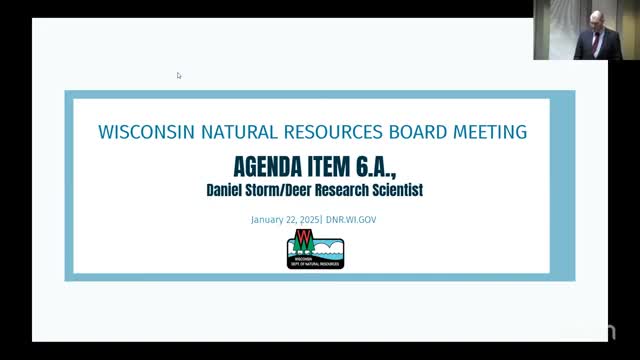Study reveals chronic wasting disease drastically reduces deer survival rates in Wisconsin
December 19, 2024 | Department of Natural Resources, Executive Departments, Executive, Wisconsin
This article was created by AI summarizing key points discussed. AI makes mistakes, so for full details and context, please refer to the video of the full meeting. Please report any errors so we can fix them. Report an error »

In a recent Natural Resources Board meeting held on January 22, 2025, experts from the Wisconsin Department of Natural Resources (DNR) presented alarming findings regarding the impact of Chronic Wasting Disease (CWD) on local deer populations. The meeting, which drew attention from board members and the public alike, highlighted the growing prevalence of CWD, a fatal neurological disease affecting deer, which has now been detected in wild populations across at least 48 counties in Wisconsin.
The presentation began with a stark overview of the situation: CWD prevalence rates in certain areas have reached as high as 55% in adult bucks and 44% in adult does. This significant spread raises critical questions about the future of deer populations in the state. The primary concern, as outlined by the researchers, is the disease's detrimental effect on the survival rates of adult female deer, which are crucial for population stability.
To investigate these impacts, researchers collared over a thousand deer, tracking their health and survival rates over time. The findings revealed a stark contrast between infected and uninfected deer: while uninfected females had an annual survival rate exceeding 80%, those with CWD saw their survival rates plummet to around 50%. This decline in survival rates directly correlates with a decrease in population growth potential, particularly in areas where CWD prevalence exceeds 30%.
The researchers emphasized that while deer populations can exhibit compensatory growth mechanisms—where lower population densities can lead to higher reproductive rates—the overarching trend indicates that in regions with high CWD prevalence, population declines are likely. This is particularly concerning for southwestern Wisconsin, where the disease has been most prevalent.
Board members engaged in a robust discussion following the presentation, raising questions about the implications of these findings for deer management strategies. They explored the potential for natural population control in areas with high deer densities and the need for long-term planning to address the multifaceted challenges posed by CWD.
As the meeting concluded, the urgency of the situation was clear. With CWD spreading and its effects becoming increasingly pronounced, the DNR faces the daunting task of managing deer populations while ensuring the health of the ecosystem. The board's discussions underscored the importance of continued research, public engagement, and adaptive management strategies to mitigate the impacts of this devastating disease on Wisconsin's deer herds.
The presentation began with a stark overview of the situation: CWD prevalence rates in certain areas have reached as high as 55% in adult bucks and 44% in adult does. This significant spread raises critical questions about the future of deer populations in the state. The primary concern, as outlined by the researchers, is the disease's detrimental effect on the survival rates of adult female deer, which are crucial for population stability.
To investigate these impacts, researchers collared over a thousand deer, tracking their health and survival rates over time. The findings revealed a stark contrast between infected and uninfected deer: while uninfected females had an annual survival rate exceeding 80%, those with CWD saw their survival rates plummet to around 50%. This decline in survival rates directly correlates with a decrease in population growth potential, particularly in areas where CWD prevalence exceeds 30%.
The researchers emphasized that while deer populations can exhibit compensatory growth mechanisms—where lower population densities can lead to higher reproductive rates—the overarching trend indicates that in regions with high CWD prevalence, population declines are likely. This is particularly concerning for southwestern Wisconsin, where the disease has been most prevalent.
Board members engaged in a robust discussion following the presentation, raising questions about the implications of these findings for deer management strategies. They explored the potential for natural population control in areas with high deer densities and the need for long-term planning to address the multifaceted challenges posed by CWD.
As the meeting concluded, the urgency of the situation was clear. With CWD spreading and its effects becoming increasingly pronounced, the DNR faces the daunting task of managing deer populations while ensuring the health of the ecosystem. The board's discussions underscored the importance of continued research, public engagement, and adaptive management strategies to mitigate the impacts of this devastating disease on Wisconsin's deer herds.
View full meeting
This article is based on a recent meeting—watch the full video and explore the complete transcript for deeper insights into the discussion.
View full meeting
